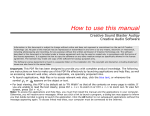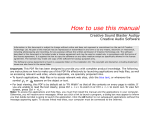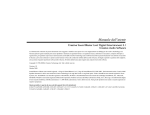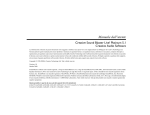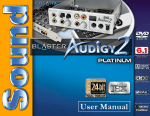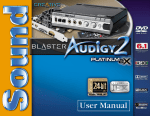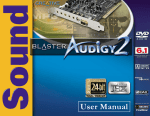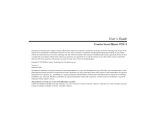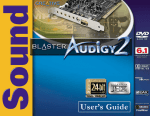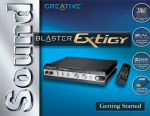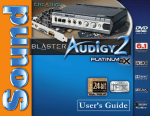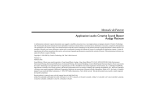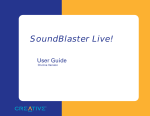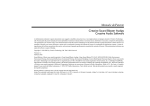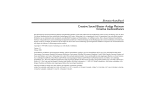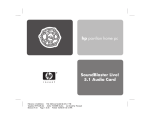Download Creative Sound Blaster Audigy Platinum Specifications
Transcript
How to use this manual Creative Sound Blaster Audigy Platinum Creative Audio Software Information in this document is subject to change without notice and does not represent a commitment on the part of Creative Technology Ltd. No part of this manual may be reproduced or transmitted in any form or by any means, electronic or mechanical, including photocopying and recording, for any purpose without the written permission of Creative Technology Ltd. The software described in this document is furnished under a license agreement and may be used or copied only in accordance with the terms of the license agreement. It is against the law to copy the software on any other medium except as specifically allowed in the license agreement. The licensee may make one copy of the software for backup purposes only. The Software License Agreement is found in a separate folder on this installation CD. The copyright and disclaimer, including trademark issues are also found in the same folder. Important: This PDF file has been designed to provide you with complete product knowledge. The following are instructions on how to make use of this PDF file effectively by launching applications and help files, as well as accessing relevant web sites, where applicable, via specially prepared links. • To launch applications, Help files or to access relevant web sites, click the blue text, or whenever the symbol or appears on the object or text. • For best viewing, this PDF is by default set to "Fit Width" so that all the contents on every page is visible. If you are unable to read the text clearly, press Ctrl + <+> to zoom in or Ctrl + <-> to zoom out. To view full screen, press Ctrl + <L>. Note: To access the applications and Help files, you must first install the manual and the applications in your computer. Otherwise, you will receive error messages. When you click a link to launch a program, a dialog box may appear to inform you that Adobe Acrobat is going to launch the application. Click the All button to run subsequent applications without the message appearing again. To access linked web sites, your computer must be connected to the Internet. Contents Introduction Welcome to high-definition digital audio entertainment ....................... ix What is EAX ADVANCED HD? ............................................................ x CreativeWare .................................................................................. xi In Your Package ............................................................................. xi System Requirements ......................................................................xii Sound Blaster Audigy card and Audigy Drive...............................xii SB1394 applications, games and DVD viewing ............................xii Getting More Information................................................................ xiii More Help ..................................................................................... xiii Technical Support .......................................................................... xiii Document Conventions................................................................... xiii 1 About the Sound Blaster Audigy Card and Audigy Drive What You Need...................................................................................... 1-1 Your Sound Blaster Audigy Card .............................................................. 1-2 Your Joystick/MIDI Bracket ..................................................................... 1-3 Your Audigy Drive .................................................................................. 1-4 Connecting Headphones ................................................................ 1-5 Connecting Microphones ................................................................ 1-5 Adjusting Headphones Volume and Microphone Gain.................................. 1-6 Using the Audigy Drive control knobs .............................................. 1-6 Using Creative Surround Mixer ....................................................... 1-7 Using a Remote Control with Your Computer ............................................. 1-7 2 Installing Hardware Installation Steps ................................................................................... 2-1 Step 1: Prepare your computer ...................................................... 2-1 Step 2: Connect the Audigy Drive cables ......................................... 2-3 Step 3: Install the Audigy Drive...................................................... 2-4 ii Step 4: Install the Sound Blaster Audigy card .................................. 2-5 Step 5: Install the Joystick/MIDI bracket (optional) .......................... 2-6 Step 6: Connect cables to Sound Blaster Audigy card........................ 2-7 Step 7: Connect to power supply .................................................... 2-9 Connecting Related Peripherals.............................................................. 2-10 Connecting Speaker Systems ................................................................ 2-12 Connecting to External Consumer Devices .............................................. 2-13 Positioning Your Speakers ..................................................................... 2-14 3 Installing Software Installing Drivers and Applications............................................................ 3-1 Installing Ulead VideoStudio Application .......................................... 3-1 Windows 98 Second Edition .................................................... 3-2 Windows Me ......................................................................... 3-2 Windows 2000 ...................................................................... 3-3 Uninstalling the Applications and Device Drivers ........................................ 3-4 Reinstalling the Device Drivers ................................................................ 3-4 Updating Windows 2000 (Service Pack 2) ................................................. 3-5 Updating Windows 98 SE ........................................................................ 3-5 AC-3 SPDIF output........................................................................ 3-5 1394 storage supplement .............................................................. 3-5 Installing Digital Video Update ................................................................. 3-6 4 Sound Blaster Audigy Applications Creative Sound Blaster Audigy Applications............................................... 4-1 Third Party Sound Blaster Audigy Applications ........................................... 4-2 Creative Taskbar.................................................................................... 4-2 Creative Sound Blaster Audigy Online Quick Start ...................................... 4-2 Creative Sound Blaster Audigy Experience ................................................ 4-3 EAX Advanced HD Gold Mine Experience................................................... 4-3 Creative Diagnostics............................................................................... 4-3 iii Creative Surround Mixer ......................................................................... 4-3 Creative AudioHQ................................................................................... 4-4 SoundFont Control ........................................................................ 4-4 Device Controls ............................................................................ 4-5 Creative Keyboard ........................................................................ 4-5 MIDI Input............................................................................ 4-5 EAX Control.................................................................................. 4-5 Creative WaveStudio .............................................................................. 4-6 Creative PlayCenter................................................................................ 4-6 Creative Recorder .................................................................................. 4-6 Creative Oozic Reactor............................................................................ 4-7 Vienna SoundFont Studio........................................................................ 4-7 Creative MiniDisc Center ......................................................................... 4-8 Creative RemoteCenter........................................................................... 4-9 SoundFont Showcase ............................................................................. 4-9 Creative Restore Defaults........................................................................ 4-9 Steinberg’s Audio Applications ............................................................... 4-10 Cubasis VST (for Creative) ........................................................... 4-10 WaveLab Lite ............................................................................. 4-10 ReCycle Lite ............................................................................... 4-10 MixMeister........................................................................................... 4-11 Ulead VideoStudio Version 4.0 SE Basic .................................................. 4-11 FireNet ............................................................................................... 4-11 5 Using Applications Multimedia Playback............................................................................... 5-1 Watching DVDs ............................................................................ 5-1 Playing MP3 or WMA files ............................................................... 5-1 Playing back Wave and CD Audio files ............................................. 5-2 Playing MIDI files.......................................................................... 5-2 Creating non-General-MIDI-compliant files ...................................... 5-2 iv Digital Entertainment.............................................................................. 5-2 Watching surround movies............................................................. 5-2 Compiling personal albums ............................................................ 5-2 Content Creation.................................................................................... 5-3 Organizing SoundFont banks.......................................................... 5-3 Applying voice effects.................................................................... 5-3 Recording sound and effects .......................................................... 5-3 Capturing and editing videos .......................................................... 5-3 Advanced Content Creation ..................................................................... 5-4 Recording multi-tracks with ASIO ................................................... 5-4 Creating music ............................................................................. 5-4 Recording and transcribing music ................................................... 5-4 Recording and editing musical instruments ...................................... 5-4 Recording digital audio ................................................................... 5-5 Creating multiple effects ................................................................ 5-5 Creating and playing back SoundFonts ............................................ 5-5 Internet Entertainment ........................................................................... 5-5 Experiencing music with visual entertainment .................................. 5-5 Encoding CD songs to MP3 format .................................................. 5-5 Downloading and playing MP3 songs ............................................... 5-6 Playing MP3 songs with EAX........................................................... 5-6 Mixing MP3 songs ......................................................................... 5-6 Gaming Reference.................................................................................. 5-6 Enjoying EAX support.................................................................... 5-6 Enjoying DirectSound3D support .................................................... 5-6 Enjoying A3D 1.0 support .............................................................. 5-6 Enjoying DOS games..................................................................... 5-7 Enjoying audio presets in games .................................................... 5-7 Customizing environments for non-3D games .................................. 5-7 v Appendixes A General Specifications Features ...............................................................................................A-1 PCI Bus Mastering .................................................................A-1 Audigy Processor ...................................................................A-1 High Quality Audio Path..........................................................A-1 Professional Digital Audio Processing........................................A-2 Flexible Mixer Control.............................................................A-2 Dolby Digital (AC-3) Decoding.................................................A-2 Creative Multi Speaker SurroundTM (CMSSTM) .........................A-3 SB1394TM Compatibility.........................................................A-3 Connectivity ..........................................................................................A-4 Sound Blaster Audigy card ............................................................. A-4 Audio Inputs .........................................................................A-4 Audio Outputs .......................................................................A-4 SB1394 Interfaces .................................................................A-5 Interfaces .............................................................................A-5 Audigy Drive ................................................................................ A-5 Audio/Video Inputs and Outputs On Front Panel ........................A-5 Interfaces .............................................................................A-6 B SB Emulation in MS-DOS/Windows 98 SE Background...........................................................................................B-1 Installing MS-DOS Drivers.......................................................................B-1 Opening MS-DOS ...................................................................................B-1 Understanding the Installation Program ....................................................B-2 AUTOEXEC.BAT File Settings .......................................................... B-2 CONFIG.SYS File Settings .............................................................. B-3 System Resource Settings.......................................................................B-3 Input/Output (I/O) Addresses ........................................................ B-4 vi Interrupt Request (IRQ) Line.......................................................... B-4 Direct Memory Access (DMA) Channel............................................. B-5 Environment Variables............................................................................B-5 CTSYN Environment Variable.......................................................... B-5 BLASTER Environment Variable ...................................................... B-5 Determining Resources...........................................................................B-6 Selecting the Best Audio Options in a Game ..............................................B-7 Music Options............................................................................... B-8 Digital Audio Options..................................................................... B-8 MS-DOS Mode Utilities............................................................................B-8 SBECFG.EXE ................................................................................ B-8 SBEMIXER.EXE ............................................................................. B-9 SBESET.EXE............................................................................... B-10 SBEGO.EXE................................................................................ B-11 C Troubleshooting Problems Installing Software ...................................................................C-1 Problems with Sound..............................................................................C-2 Insufficient SoundFont Cache ..................................................................C-5 Problems With Joystick ...........................................................................C-5 Problems with Multiple Audio Devices .......................................................C-6 Problems with Sound Blaster Live! Series or Sound Blaster PCI512 card .......C-7 Resolving I/O Conflicts............................................................................C-8 Problems in Windows NT 4.0 ...................................................................C-9 Problems with Encore DVD Player .......................................................... C-10 Problems with Software DVD Player ....................................................... C-10 Problems with DV driver for Windows 98 SE/2000/Me .............................. C-11 Index vii Introduction Introduction Welcome to highdefinition digital audio entertainment Thank you for purchasing Sound Blaster Audigy Platinum, which consists of the Sound Blaster Audigy card, the Audigy Drive and the IR remote control. It is the most complete high-definition digital audio entertainment solution that you will ever come across. With the onboard 24-bit Analog-to-Digital Converter (ADC) and Digital-to-Analog Converter (DAC), Sound Blaster Audigy Platinum delivers high-definition sound of astounding quality with 96 kHz SPDIF support. The Sound Blaster Audigy card, with its Audigy processor, is four times as powerful as its nearest competitor. This enables awesome EAX ADVANCED HDTM technologies for your games and music listening experience. The Audigy Drive is designed for your convenience. On its front panel, you can plug in your microphone and headphones, and adjust the gain/volume. The Audigy Drive also provides Creative SB1394, MIDI, and digital connectors for your audio/video recording and content authoring purposes. The SB1394 port provides easy highspeed connectivity to NOMAD portable digital audio players, external CD-RW drives and other IEEE 1394 compatible devices like DV Camcorders, printers, scanners and digital still cameras. In addition, the Audigy Drive can be used with an IR remote control. The infrared receiver on the Audigy Drive lets you control your computer and perform tasks (such as playing audio CDs and video CDs) up to a distance of four meters. Combine Sound Blaster Audigy Platinum with a rich software bundle and you get endless hours of fun. Included in your Sound Blaster Audigy Installation CD are exciting applications that allow you to create EAX-enhanced MP3 songs, and instant interactive Oozic music videos, which you can share with your friends over the Internet. Introduction ix What is EAX ADVANCED HD? EAX ADVANCED HD brings a new level of performance, power and flexibility to PC audio. Taking advantage of the increased processing capabilities of the Sound Blaster Audigy HDA Processor, EAX ADVANCED HD delivers a host of new high definition audio features for gaming and music enhancement. The all-new EAX ADVANCED HD Game Audio Library takes in-game audio acoustics to a whole new level. New Multi-EnvironmentTM technology renders up to 4 simultaneous audio environments in real time. Environment PanningTM makes spatializing and localizing environments in 3D possible. Environment ReflectionsTM offers localization of early reflections and echoes. Environment FilteringTM accurately simulates the propagation of sound in both open and closed environments. Finally, Environment MorphingTM allows for seamless transition from one environment to the next. These innovative technologies bring tremendous realism and immersiveness to gaming. Sonic superiority is also assured with EAX ADVANCED HD Music Technologies. Audio Clean-Up enables the removal of unwanted noise in a digital audio file. DREAMTM creates an enhanced, "disco-like" surround sound for any stereo music. Time Scaling speeds up and slows down music with no distortion. Music playback is further enhanced with the specially developed EAX ADVANCED HD music effects. EAX ADVANCED HD offers dramatically increased 3D audio performance and functionality, delivering superior audio fidelity and sophisticated reverb effects for an unsurpassed digital entertainment experience that is only available from the Sound Blaster Audigy family of products. Introduction x CreativeWare CreativeWare is a post-purchase programme that adds new features, enhancements and additional functionality to Creative’s upgradeable products. With CreativeWare, you can always be sure of having the best digital entertainment experience because: - You can easily upgrade your Sound Blaster Audigy card with the latest features, device drivers, and applications. - You can personalize the functions on your Sound Blaster Audigy card. In Your Package The items listed here may differ for certain countries. The following items are included in your package: ❑ Sound Blaster Audigy card ❑ Audigy Drive and IR remote control ❑ Joystick/MIDI bracket ❑ Internal SB1394 cable ❑ Wide gray cable ❑ Analog CD audio cable ❑ Digital CD audio cable ❑ Power splitter cable ❑ Mini-DIN-to-standard-DIN adapter ❑ 3.5 mm minijack to ¼” jack adapter ❑ 4 screws + shunt (for microphone selection) ❑ 2 non-alkaline AAA batteries (twin pack) for the IR remote control ❑ Sound Blaster Audigy Installation CD ❑ Application and game CDs ❑ Quick Start leaflet ❑ Warranty card ❑ Technical Support leaflet Introduction xi System Requirements Sound Blaster Audigy card and Audigy Drive ❑ Genuine Intel® Pentium® 266 MHz, AMD® K6 300 MHz or faster processor ❑ Intel, AMD or 100% compatible motherboard chipset ❑ Windows 98 Second Edition (SE), Windows Millennium Edition (Me), Windows NT 4.0 or Windows 2000 ❑ 64 MB RAM ❑ 600 MB of free hard disk space ❑ Available PCI 2.1 compliant slot for the Sound Blaster Audigy card ❑ Available adjacent slot for the Joystick/MIDI bracket (optional) ❑ Available 5 ¼” drive bay for the Audigy Drive ❑ Headphones or amplified speakers (available separately) ❑ CD-ROM drive installed SB1394 applications, games and DVD viewing ❑ Genuine Intel Pentium II 350 MHz, MMX or AMD 450 MHz processor/3Dnow! ❑ Windows 98 SE, Windows Me or Windows 2000 (Creative PlayCenter on Windows NT 4.0 requires Service Pack 6 with Internet Explorer 4.0) ❑ 3D graphics accelerator with at least 8 MB of texture RAM for games ❑ 128 MB RAM recommended for digital video (DV) capture and editing ❑ Ultra DMA type hard disk space with 1 GB workspace (ATA-100, 7,200 rpm type and 6 GB recommended) for DV applications (300—500 MB of free hard disk space for games) ❑ At least second generation DVD-ROM drive with these recommended soft-DVD players: InterVideo’s WinDVD 2000 or CyberLink’s PowerDVD 3.0 and above Other applications may have higher system requirements or may require a microphone. Refer to the individual application’s online Help for details. Introduction xii Getting More Information Refer to the Sound Blaster Audigy Online Quick Start and the various online Help files for detailed information on Creative applications. The Sound Blaster Audigy Experience, an online demo, gives you an interactive introduction to Sound Blaster Audigy and demonstrates the card’s capabilities. More Help View the contents of the Sound Blaster Audigy Installation CD for additional demonstrations, libraries and other software. Visit the www.soundblaster.com site for the latest Sound Blaster news and products. The site also includes information on making purchases, technical help, and CreativeWare updates. Technical Support Visit http://www.soundblaster.com/support/faq/ for general help. Document Conventions The following typographical conventions are used throughout this manual: The notepad icon indicates information that is of particular importance and should be considered before continuing. The alarm clock designates a caution or warning that can help you avoid situations involving risk. The warning sign indicates that failure to adhere to directions may result in bodily harm or life-threatening situations. Introduction xiii 1 About the Sound Blaster Audigy Card and Audigy Drive This chapter gets you ready to install the Sound Blaster Audigy Platinum hardware. About the Sound Blaster Audigy Card and Audigy Drive What You Need Before you begin installation, be sure that you have these: In addition, you will also need an available PCI slot and another adjacent available slot on your computer. Sound Blaster Audigy Drive Sound Blaster Audigy card Internal SB1394 cable Wide gray cable Joystick/MIDI bracket Digital CD audio cable Shunt Screws Philips-head screwdriver (not included) Analog CD audio cable About the Sound Blaster Audigy Card and Audigy Drive 1-1 Your Sound Blaster Audigy Card A jack is a one-hole connecting interface whilst a connector consists of many pins. Refer to the User Guide, “Hardware Information”, for connector pin assignments. In Analog mode, Line Out and Rear Out jacks can be used simultaneously for 4.1 channel speaker systems. The Analog/Digital Out jack can be used for the Center and Subwoofer (LFE) channels for 5.1 speaker systems. Your audio card has these jacks and connectors that allow you to attach other devices: CD Audio connector (CD_IN) Connects to the Analog Audio output on a CD-ROM or DVD-ROM drive using a CD audio cable. Telephone Answering Device connector (TAD) Provides a mono connection from a standard voice modem, and transmits microphone signals to the modem. Analog/Digital Out jack 6-channel or compressed AC-3 SPDIF output for connection to external digital devices or digital speaker systems. Also supports Center and Subwoofer analog channels for connection to 5.1 analog speaker systems. Line In jack (LIN_IN) Connects to an external device (such as a cassette, DAT or MiniDisc player). Microphone In jack (MIC_IN) Connects to an external microphone for voice input. Line Out jack (LIN_OUT1) Connects to powered speakers or an external amplifier for audio output. Also supports headphones. Rear Out jack (LIN_OUT2) Connects to powered speakers or an external amplifier for audio output. AUX In connector (AUX_IN) Connects to internal audio sources such as TV Tuner, MPEG, or other similar cards. Internal SB1394 port Connects to J5 on the Audigy Drive. CD SPDIF connector (CD_SPDIF) Connects to the SPDIF (Digital Audio) output (where available) on a CDROM or DVD-ROM drive. Joystick/MIDI connector (JOYSTICK) Connects to the Joystick/MIDI cable. Audio Extension (Digital I/O) connector (AUD_EXT) Connects to the external Audigy Drive or Digital I/O card. Warning: This is not an IDE interface. Do not connect it to your IDE devices. SB1394 port (SB1394) Connects to an IEEE1394 compatible external device (such as a digital video camcorder, digital still camera, printer or scanner). Figure 1-1: Jacks, connectors and ports on the Sound Blaster Audigy card. About the Sound Blaster Audigy Card and Audigy Drive 1-2 Your Joystick/ MIDI Bracket Your Joystick/MIDI bracket provides connectivity to joysticks or MIDI devices: Joystick/MIDI connector Rear view of connector bracket Connects to a joystick or MIDI device. You can buy an optional MIDI kit that allows you to plug in a joystick and MIDI devices simultaneously. Figure 1-2: Joystick/MIDI bracket. About the Sound Blaster Audigy Card and Audigy Drive 1-3 Your Audigy Drive • To connect your existing computer headphones and microphone to the Audigy Drive, use a 3.5mm to ¼” adapter (optional). • Set the gain of the Mic In 2 jack to the minimum before connecting or turning on a microphone, especially if you are using headphones. The front panel of your Audigy Drive has these jacks, connectors and controls: RCA Auxiliary In jacks Connects to consumer equipment such as VCR, TV and CD players, via RCA Auxiliary audio outputs. Optical SPDIF In/Out connectors Connects to digital audio devices such as DAT and MiniDisc recorders, via optical input/output. Infrared Receiver Lets you control your computer using the IR remote control. MIDI In/Out connectors Connects to MIDI devices using the mini DIN-to-Standard DIN adapter provided. RCA SPDIF In/Out jacks Connects to digital audio devices such as DAT and MiniDisc recorders, via RCA input/output. ¼” Headphones jack Connects to a pair of high-quality headphones. Your speaker output is muted when you connect the headphones to the drive. Line In 2/Mic In 2 selector (Microphone Gain Control) To switch to Line In 2, turn the knob counter clockwise over the Line In 2/Mic In 2 separator mark until you hear a “click” sound. To switch back to Mic In 2, turn the knob clockwise over the separator mark until you hear a “click” sound. To control the microphone gain, continue to turn clockwise. See “Adjusting Headphones Volume and Microphone Gain” on page 1-6. Headphones Volume Control Controls the headphones output volume. See “Adjusting Headphones Volume and Microphone Gain” on page 1-6. ¼” Line In 2/Mic In 2 jack Connects to a high-quality dynamic microphone or audio devices such as electric guitars and DAT or MiniDisc players. SB1394 connector Connects to IEEE 1394 compatible devices. Line In 2/Mic In 2 separator mark Figure 1-3: Jacks, connectors and controls on the Audigy Drive. About the Sound Blaster Audigy Card and Audigy Drive 1-4 Connecting Headphones There are two types of headphones that you can connect to your Audigy Drive: ❑ Home audio or professional audio headphones, which are usually fitted with a ¼" stereo plug. ❑ Personal stereo headphones, which are usually fitted with a 3.5 mm stereo plug, such as those used for portable audio players. Connecting Microphones There are two types of microphones that you can connect to your Audigy Drive: ❑ Dynamic microphone, which is usually fitted with a ¼" stereo plug, such as those used in vocal performances. ❑ Condenser microphone, which is usually fitted with a 3.5 mm stereo plug, such as the microphone bundled with Creative audio products. • The Jumper JP1 may not be available on certain models of Audigy Drive. • The shunt for Jumper JP1 can be found together with the packet of screws provided. Shunt Shunt To use a dynamic microphone, place the shunt onto Jumper JP1. Jumper JP1 To use a condenser microphone, remove the shunt from Jumper JP1 (default setting). Jumper JP1 Figure 1-4: Microphone jumper settings. By default, your Audigy Drive is set for use with a condenser microphone. To use a dynamic microphone, you must place the shunt (jumper cap) onto Jumper JP1 on your Audigy Drive. See Figure 2-3 on page 2-3 for the location of Jumper JP1 on your Audigy Drive. About the Sound Blaster Audigy Card and Audigy Drive 1-5 Adjusting Headphones Volume and Microphone Gain You can adjust the headphones volume and microphone gain in two ways. Using the Audigy Drive control knobs On the front panel of the external Audigy Drive, turn the respective control knob: ❑ Counterclockwise to decrease the headphones volume or microphone gain. ❑ Clockwise to increase the headphones volume or microphone gain. About the Sound Blaster Audigy Card and Audigy Drive 1-6 Using Creative Surround Mixer To install Surround Mixer and other applications, see “Installing Drivers and Applications” on page 3-1. • For best effects, set the headphones volume and microphone gain levels to 75% in Surround Mixer, and then use the external Audigy Drive’s control knobs to make further adjustments. • If you set the headphones volume or microphone gain levels to 0%, or mute them in Surround Mixer, you hear no sound if the external Audigy Drive’s control knobs are set to the maximum. Using a Remote Control with Your Computer To adjust headphones volume: 1. Click Start -> Programs -> Creative -> Sound Blaster Audigy -> Surround Mixer. 2. On the lower half of Surround Mixer, make sure that the Mute check box under the Volume slider is clear. Otherwise, click the check box. 3. Drag the Volume slider up or down to adjust the headphones volume. To adjust microphone gain: 1. Click Start -> Programs -> Creative -> Sound Blaster Audigy -> Surround Mixer. 2. On the lower half of Surround Mixer, click an audio input source button with a down arrow, and then select Line-In 2/Mic 2. 3. Make sure the check box below the Line-in 2/Mic 2 slider is cleared. If not, click it to clear the check box. This will unmute the audio input source. 4. Drag the slider up or down to adjust the microphone gain. The external Audigy Drive has an infrared receiver for the remote control. This remote control lets you operate your computer from the comfort of your sofa or bed up to a distance of 4 meters. For details, refer to the RemoteCenter online Help. About the Sound Blaster Audigy Card and Audigy Drive 1-7 2 Installing Hardware This chapter tells you how to install the Sound Blaster Audigy hardware Installing Hardware Installation Steps Step 1: Prepare your computer • Position your CD-ROM/ DVD-ROM drive above the Audigy Drive to prevent the cables dangling at the front panel of the Audigy drive from blocking access to the drive tray. • If you are not installing a joystick or MIDI device, remove only one metal bracket. 1. Turn off your computer and all peripheral devices. 2. Touch a metal plate on your computer to ground yourself and to discharge any static electricity, and then unplug the power cord from the wall outlet. 3. Remove the computer cover. 4. Remove the metal brackets from two adjacent unused PCI slots as shown in Figure 2-1. Put the screws aside for use later. metal bracket PCI slot Turn off the main power supply and disconnect your computer’s power cord. Systems using an ATX power supply unit with soft power off may still be powering the PCI slot. This can damage your audio card when it is inserted into the slot. ISA slot Figure 2-1: Removing metal brackets. Installing Hardware 2-1 5. Remove the front panel cover from an unused 5¼” drive bay, as shown in Figure 2-2. 5¼” drive bay cover Figure 2-2: Removing 5¼” drive bay cover. Installing Hardware 2-2 Step 2: Connect the Audigy Drive cables Connect the cables to the Audigy Drive as shown in Figure 2-3. To system power supply unit Internal SB1394 cable Power splitter cable Jumper for microphone type selection JP1 J5 J1 Red-colored wire Wide gray cable Audigy Drive Black circle on the underside of the cable Figure 2-3: Connecting the Audigy Drive cables. Installing Hardware 2-3 Step 3: Install the Audigy Drive 1. Slide the Audigy Drive fully into the vacant 5¼” drive bay as shown in Figure 2-4. 2 1 Figure 2-4: Installing the Audigy Drive. 2. Secure its sides to the casing with the screws provided. Installing Hardware 2-4 Step 4: Install the Sound Blaster Audigy card 1. Align the Sound Blaster Audigy card with the PCI slot and press the audio card gently but firmly into the slot as shown in Figure 2-5. 2 Remove any existing audio card and disable the onboard audio. For more information, see “Problems with Multiple Audio Devices” on page C-6. Do not force the audio card into the slot. Make sure that the gold finger PCI connector on the Sound Blaster Audigy card is aligned with the PCI bus connector on the motherboard before you insert the card into the PCI expansion slot. If it does not fit properly, gently remove it and try again. 1 PCI slot Figure 2-5: Inserting the Sound Blaster Audigy card into the PCI slot. 2. Secure the audio card with one of the screws that you placed aside earlier. Installing Hardware 2-5 Step 5: Install the Joystick/MIDI bracket (optional) If you are installing a joystick or a MIDI device, secure the Joystick/MIDI bracket to the slot next to the Sound Blaster Audigy card with the second screw, as shown in Figure 2-6. Joystick/MIDI bracket Figure 2-6: Securing the Joystick/MIDI Bracket to the computer casing. Installing Hardware 2-6 Step 6: Connect cables to Sound Blaster Audigy card 1. Connect the Joystick/MIDI cable to the Joystick/MIDI connector on the Sound Blaster Audigy card as shown in Figure 2-7. Internal SB1394 cable 3 Wide gray cable 1 2 Joystick/MIDI cable Figure 2-7: Connecting the cables to the Sound Blaster Audigy card. 2. Connect the Wide gray cable from the Audigy Drive to the AUD_EXT connector on the Sound Blaster Audigy card. 3. Connect the Internal SB1394 cable from the Audigy Drive to the Internal SB1394 port on the Sound Blaster Audigy card. Installing Hardware 2-7 For analog CD audio output: If the Sound Blaster Audigy card is connected to both the CD SPDIF and CD Audio connectors on a CD-ROM or DVD-ROM drive, do not enable CD Audio and CD Digital options at the same time in Surround Mixer. connect the Analog CD audio cable from the Analog Audio connector on your CDROM/DVD-ROM drive to the CD_IN connector on the Sound Blaster Audigy card as shown in Figure 2-8. Analog CD audio cable Digital CD audio cable Figure 2-8: Connecting analog/digital audio cables to CD-ROM/DVD-ROM drives. For digital CD output: connect the Digital CD audio cable from the Digital Audio connector on your CDROM/DVD-ROM drive to the CD_SPDIF connector on the Sound Blaster Audigy card. Installing Hardware 2-8 Step 7: Connect to power supply 1. Connect the power splitter cable from the Audigy Drive to the system power supply unit. 2. Replace the computer cover. 3. Plug the power cord back into the wall outlet, and turn on the computer. To connect Sound Blaster Audigy Platinum to other devices, see “Connecting Related Peripherals” on page 2-10. To install drivers and software, see “Installing Drivers and Applications” on page 3-1. Installing Hardware 2-9 Sound Blaster Audigy Platinum will undoubtedly give you endless hours of listening pleasure. Figure 2-9 and Figure 2-10 shows you how to connect related peripherals to your Sound Blaster Audigy Platinum to optimize your enjoyment. Connecting Related Peripherals Analog/Digital Out jack Analog Mode (default): Connects to Center and Subwoofer channels. Digital Mode: Connects to digital speakers*, MiniDisc or DAT via minijack-to-DIN cable. CD/DVD-Rom drive For instructions on how to switch between digital and analog modes, refer to topic “Digital Output Only” of the Creative Surround Mixer online Help. Digital CD audio cable Analog CD audio cable Cassette, CD player, Synthesizer, etc. Line In Mic In Line Out Line-out Rear Out SB1394 port Microphone Sound Blaster Audigy card Connects to analog front and rear inputs of 4-channel speakers** For network games and SB1394 compatible devices such as the IEEE 1394 Creative digital audio player, DV Camcorder, Webcam and Digital Camera. Joystick/MIDI bracket Game pad Connects to Audigy Drive or Digital I/O card. See “Connecting Speaker Systems” on page 2-12 for more details. * For example, Creative InspireTM 5.1 Digital Speakers ** For example, 4-channel Creative or Cambridge SoundWorks analog speaker systems Figure 2-9: Connecting other devices. Installing Hardware 2-10 Watching DVD Movies with Creative SoftPC-DVD and Creative Inspire 5.1 Digital Speakers Recording and Content Authoring with Audigy Drive Connecting IEEE 1394 compatible devices with SB1394 connector Digital devices such as DAT recorders MiniDisc player Analog devices such as CD or tape players Creative Inspire 5.1 Digital Speakers Dolby Digital (AC-3) SPDIF In Digital video camcorder IEEE 1394 hard disk Audigy Drive Digital DIN IEEE 1394 CD-RW drive via Mini-DIN-to-standard DIN adapter (provided) Headphones Microphone MIDI devices (For or example, MIDI Line In keyboard) Figure 2-10:Connecting peripherals to the Audigy Drive. Installing Hardware 2-11 Connecting Speaker Systems If you are playing games in Windows 98 SE MS-DOS mode (pure DOS mode), you must: • Make sure the CD Audio connector on the Sound Blaster Audigy card and the Analog Audio connector of the CD-ROM or DVD-ROM drive are connected. • In addition, if you get distorted sound, do not connect the CD SPDIF connector on the Sound Blaster Audigy card to the Digital Audio connector on the CD-ROM or DVD-ROM drive. For instructions on how to switch between the analog and digital modes of the Digital/Analog jack, see “Digital Output Only” of the Creative Surround Mixer online Help. If you have a 5.1 channel speaker system, you can upmix your stereo sources (such as CD Audio, MP3, WMA, MIDI and Wave) to 5.1 channels by using the Creative Multi Speaker Surround (CMSS) technology. To upmix, you need to enable the CMSS feature in PlayCenter. Refer to the PlayCenter online Help. Analog/Digital Out jack Playing Games, Music or Watching Movies with 4.1 or 5.1 Digital Speaker Systems from Creative or Cambridge SoundWorks Minijack-toDIN cable Analog Line Digital and Rear DIN Inputs Playing Games, Music or Watching Movies with an Analog 5.1 channel speaker system* *For example, Creative Inspire 5.1 Analog Speakers Connects to the Audigy Drive. Line Out Rear Out Triple stereo audio cable Analog Front, Rear and Center/ Sub Inputs Figure 2-11:Connecting speaker systems to the Sound Blaster Audigy card. Installing Hardware 2-12 Connecting to External Consumer Devices Dolby Digital Decoder/Amplifier Analog/Digital Out jack 3.5mm(mono)-to-RCA cable Dolby Digital (AC-3) SPDIF In Connects to the Audigy Drive. Line Out Rear Out Sound Blaster Audigy card Discrete 6-channel Analog Amplifier 3.5mm (stereo)-to-RCA cables Analog Front, Rear and Center/Sub Inputs Tip : Left / Center channel Ring : Right / Subwoofer channel Additional information for advanced users: For connection to Center and Subwoofer channels using a 3.5mm (stereo)-to-RCA cable, connect the white RCA jack to the Center input and the red RCA jack to the Subwoofer input of the amplifier. Figure 2-12:Connecting external consumer devices to the Sound Blaster Audigy card. Installing Hardware 2-13 Positioning Your Speakers If you are using four speakers, place them so that they form the corners of a square with you exactly in the center (Figure 2-13) and that they are angled toward you. Be sure that the computer monitor is not blocking the path of your front speakers. You may want to adjust the relative positions of the speakers until you get the audio experience you like best. If you have a subwoofer, place the unit in a corner of the room for the best bass experience. Subwoofer Center Center speaker Front right speaker Front left speaker You Rear left speaker Rear right speaker Figure 2-13:Recommended speaker positions. Installing Hardware 2-14 3 Installing Software This chapter tells you how to install the Sound Blaster Audigy Platinum software. Installing Software Installing Drivers and Applications During the installation process, Windows 98 SE users will be prompted to insert the Windows 98 SE installation CD into the CDROM drive. Insert the installation CD into the CDROM drive and then click the OK button. Installing Ulead VideoStudio Application You need to install device drivers and applications to use Sound Blaster Audigy Platinum. To install these drivers and the bundled applications, use the following instructions. The instructions are applicable to all supported Windows operating systems. 1. After you have installed the Sound Blaster Audigy card and Audigy Drive, turn on your computer. Windows automatically detects the audio card and device drivers. 2. When prompted for the audio drivers, click the Cancel button. 3. Insert the Sound Blaster Audigy installation CD into your CD-ROM drive. The disc supports Windows AutoPlay mode and starts running automatically. If not, you need to enable your CD-ROM drive’s auto-insert notification feature. For more details, see “Problems Installing Software” on page C-1. 4. Follow the instructions on the screen to complete the installation. 5. When prompted, restart your system. Refer to the section which applies to your Windows operating system. Installing Software 3-1 Windows 98 Second Edition In Windows 98 SE, Windows Me and Windows 2000, to verify that the driver was installed successfully, click Start -> Settings -> Control Panel. Double-click the System icon. Click the Device Manager tab and double-click Sound, video and game controllers. You should see a list of Creative devices. Windows Me 1. Connect your digital video (DV) camcorder to the Sound Blaster Audigy card and turn it on. 2. If prompted, insert the Windows 98 SE CD into the CD-ROM drive and click the OK button. 3. If a Version Conflict message appears, click the Yes button to continue the installation. 4. Insert the Ulead VideoStudio installation CD into your CD-ROM drive. 5. Follow the instructions on the screen to complete the setup. 6. If prompted, click the Yes button to let the setup program detect the MS DV drivers. 7. If prompted to install the Windows 98/98 Second Edition Qxxxxxx Update, click the Yes button. 8. When prompted, restart your system. 1. Connect your digital video (DV) camcorder to the Sound Blaster Audigy card and turn it on. 2. If prompted, insert the Windows Me CD into the CD-ROM drive and click the OK button. 3. Insert the Ulead VideoStudio installation CD into your CD-ROM drive. 4. Follow the instructions on the screen to complete the setup. 5. If prompted, click the Yes button to let the setup program detect the MS DV drivers. 6. When prompted, restart your system. Installing Software 3-2 Windows 2000 1. Connect your digital video (DV) camcorder to the Sound Blaster Audigy card and turn it on. 2. Insert the Ulead VideoStudio installation CD into your CD-ROM drive. 3. If prompted, click the Yes button to let the setup program detect the MS DV drivers. 4. When prompted, restart the system. Installing Software 3-3 Uninstalling the Applications and Device Drivers You may at times need to uninstall and then reinstall the applications to correct problems, change configurations, or make version upgrades. The following instructions tell you how to uninstall the applications in all Windows operating systems. 1. Close all audio card applications. This includes Creative TaskBar. Applications that are still running during the uninstallation will not be removed. 2. Click Start -> Settings -> Control Panel. 3. Double-click the Add/Remove Programs icon. 4. Click the Install/Uninstall tab and select Sound Blaster Audigy. Click the Add/Remove button. 5. When the Creative Uninstaller dialog box appears, click the check boxes of the items you want to delete and click the Next button. The selected applications will be uninstalled. 6. Click the OK button. 7. If prompted, restart your computer. Reinstalling the Device Drivers You may at times need to reinstall only the device drivers because of driver corruption. 1. Insert the Sound Blaster Audigy installation CD into the CD-ROM drive. The disc supports Windows AutoPlay mode and starts running automatically. If not, see “Problems Installing Software” on page C-1. 2. Follow the instructions on the screen until the Setup Options dialog box appears. 3. Click the Drivers only button. 4. Follow the instructions on the screen to complete the installation of the device drivers. Installing Software 3-4 Updating Windows 2000 (Service Pack 2) Windows 2000 now provides better support for AC-3 SPDIF output (non-PCM through waveOut) for software DVD viewing. Click the website address below to go to Microsoft’s Windows 2000 web site to download the Windows 2000 Service Pack 2 to enjoy this support and to fix other issues in the Windows 2000 OS. http://microsoft.com/windows2000/server/evaluation/news/bulletins/sp2.asp Updating Windows 98 SE AC-3 SPDIF output AC-3 SPDIF output (Non-PCM through waveOut) support is also available to Windows 98 SE users. Click the address below to go to the Microsoft Product Support Services, where you can request the update package (269601USA8.EXE). http://www.microsoft.com/HWDEV/audio/Non-PCM.htm 1394 storage supplement A Safe Removal utility that allows you to safely stop a plug-and-play storage device before disconnecting the device, and to provide an update for 1394 drivers related to surprise removal of peripheral device is available form the web site below. If you disconnect a 1394 storage device from your computer immediately after it is disabled, you may do some damage to it. With these storage device drivers, expect large performance improvements of nearly 300%, as well as protect your investment. www.microsoft.com/windows98/downloads/contents/WURecommended/ S_WUFeatured/1394/Default.asp Installing Software 3-5 Installing Digital Video Update If you have installed DirectX 8.0 or 8.0a run time, install the latest update for this application. This update provides 1394 Digital Video equipment users PAL support and improved device support. This is applicable for Windows 98 SE and Windows 2000 users. This update provides minor improvement to the Windows Me OS. To do this, go to the web site below. www.microsoft.com/downloads/release.asp?ReleaseID=28377 Installing Software 3-6 4 Sound Blaster Audigy Applications This chapter tells you about the applications bundled with your Sound Blaster Audigy Platinum. Sound Blaster Audigy Applications Creative Sound Blaster Audigy Applications Sound Blaster Audigy is supported by a full range of applications to help you get the most from your audio card. The following set of software is most important to the operation of your audio card: ❑ Creative Taskbar ❑ Creative Sound Blaster Audigy Online Quick Start ❑ Creative Sound Blaster Audigy Experience ❑ EAX ADVANCED HD Gold Mine Experience ❑ Creative Diagnostics ❑ Creative Surround Mixer ❑ Creative AudioHQ ❑ Creative WaveStudio ❑ Creative PlayCenter ❑ Creative Recorder ❑ Creative Oozic Reactor ❑ Vienna SoundFont Studio ❑ Creative MiniDisc Center ❑ Creative RemoteCenter ❑ SoundFont Showcase ❑ Creative Restore Defaults Sound Blaster Audigy Applications 4-1 Third Party Sound Blaster Audigy Applications Sound Blaster Audigy can best be appreciated through some of the advanced software that makes maximum use of the audio card’s features. To assist you in exploring the limitless potential of Sound Blaster Audigy, Creative has included an assortment of applications and games: ❑ Steinberg’s Audio Applications — MIDI sequencer and digital audio tools ❑ MixMeister — digital music/DJ tool ❑ Ulead VideoStudio Version 4.0 SE Basic — video editing application ❑ FireNet — IEEE 1394 network connectivity application ❑ Latest EAX ADVANCED HD Games The applications included with Sound Blaster Audigy may differ for certain countries. Creative Taskbar Creative Taskbar is an application that allows you to perform tasks with your audio card easily and quickly. Just select a task and everything is done for you — the necessary applications are started and your mixer and effects settings are configured automatically. Creative Taskbar also comes with Creative TaskGuide, which provides tips and useful links related to the selected task. For more information and usage details on Creative Taskbar, refer to its online Help. Creative Sound Blaster Audigy Online Quick Start This is a good starting point from which you can learn about Sound Blaster Audigy. The online Quick Start consists of several interactive and informative demos that feature different aspects of Sound Blaster Audigy, like experiencing digital music and digital gaming, watching movies, connecting speakers and performing tasks. Sound Blaster Audigy Applications 4-2 Creative Sound Blaster Audigy Experience Use the Creative Sound Blaster Audigy Experience to feel Sound Blaster Audigy’s awesome gaming, music listening and home studio capabilities. You will experience the advantage of multi-environment audio processing, dynamic EAX ADVANCED HD effects, high-quality surround output and EAX-enhanced home theater quality audio. Note:This application does not work in Windows NT 4.0. EAX Advanced HD Gold Mine Experience Run this demonstration, which is set in a gold mine, and experience EAX ADVANCED HD technologies such as Environment Panning, Environment Reflection and Environment Morphing. Compare the scenes with and without EAX ADVANCED HD, and understand why more game developers are using EAX ADVANCED HD technologies for the best gaming experience. Creative Diagnostics Use Creative Diagnostics to quickly test your audio card’s Wave, MIDI or CD Audio playback capability, recording function and speaker output. For more information and usage details on Creative Diagnostics, refer to its online Help. Creative Surround Mixer Creative Surround Mixer is the main application to use for the following tasks: ❑ Testing speakers ❑ Applying EAX-enabled audio effects ❑ Mixing sounds from various audio input sources ❑ Setting audio effects To restore Surround Mixer to its original settings, click Start -> Programs -> Creative -> Sound Blaster Audigy -> Creative Restore Defaults. Surround Mixer has two modes. Click the Basic Mode or Advanced Mode button to switch between the two modes: In basic mode, the Mixer panel is displayed. You can: ❑ mix sounds from various audio input sources when playing or recording ❑ control volume, bass, treble, balance and fade Sound Blaster Audigy Applications 4-3 In advanced mode, the Surround Mixer and Mixer panels are displayed. In Surround Mixer, you can: ❑ select audio effects ❑ specify the speaker output ❑ perform a speaker test For more information and usage details on Creative Surround Mixer, refer to its online Help. Creative AudioHQ AudioHQ is Creative's audio software control center. The AudioHQ interface has the standard look and feel of the Windows Control Panel. It contains several control applets that allow you to view, audition or set up the audio properties of one or more audio devices on your computer. As in Control Panel, you can view AudioHQ's control applets in the main window as large icons, small icons, list items or detailed list items. You can also select all or invert the selection when you are in the Applet view. The number of items in the main window, however, varies with the control applet or device selected. The By Audio Device view shows only the control applets supported by the selected device. The Applet view shows only the audio devices that support the selected applet. For more information and usage details on Creative AudioHQ, refer to its online Help. SoundFont Control SoundFont Control allows you to configure MIDI banks with SoundFont, DLS and Wave files and instruments, as well as set the caching algorithm and space. For more information and usage details on SoundFont Control, refer to its online Help. Sound Blaster Audigy Applications 4-4 Device Controls Device Controls lets you configure devices to allow multiple simultaneous Wave playback. For example, you can play five Wave tracks at the same time. Device Controls also allows you to enable the SPDIF Bypass feature for your digital inputs and outputs, and mute your speakers when you plug your headphones into Audigy Drive. For more information and usage details on Device Controls, refer to its online Help. Creative Keyboard Creative Keyboard is a virtual keyboard that allows you to audition or play musical notes produced through MIDI devices. To edit the sound, use Vienna SoundFont Studio or another sound editor. MIDI Input You can use external MIDI input devices to audition your MIDI banks and instruments. First, connect a MIDI input device to your audio card and then select that device in Creative Keyboard. EAX Control EAX Control allows you to configure the Sound Blaster Audigy chip's effects engine. It allows you to specify to a low level the components that make up the audio elements that in turn make up an audio effect. It promises to deliver sounds that are so life-like, you can almost see them! It is the computer industry's first system to recreate and deliver real-world, interactive audio experiences in games, music, and other audio applications. These audio effects take your computer beyond home-theater quality, immersing you in sound so vivid your imagination can almost "see it". The effects go beyond today's surround-sound and 3D positional audio and actually model an environment by taking into account room size, acoustic properties, reverb, echo and many other effects that create a realworld experience. For more information and usage details on EAX Control, refer to its online Help. Sound Blaster Audigy Applications 4-5 Creative WaveStudio Creative WaveStudio allows you to perform the following sound editing functions easily: ❑ Play, edit, and record 8-bit (tape quality) and 16-bit (CD quality) wave data ❑ Enhance wave data or create unique sounds with various special effects and editing operations such as reverse, echo, mute, pan, cut, copy, and paste ❑ Open and edit several audio files at the same time ❑ Open Raw (.RAW) and MP3 (.MP3) data files For more information and usage details on Creative WaveStudio, refer to its online Help. Creative PlayCenter Creative PlayCenter is a revolutionary audio CD and digital audio (such as MP3 or WMA) player. Besides managing your favorite digital audio files on your computer, it is also an integrated MP3/WMA encoder for ripping audio CD tracks into compressed digital audio files. It can encode tracks many times faster than normal play speed and up to 320 kbps (for MP3). For more information and usage details on Creative PlayCenter, refer to its online Help. Note:Audio files that are secured through Microsoft’s Digital Rights Management (DRM) technology can only be played back on an MS DRM supported audio player such as Creative PlayCenter. For security against unauthorized duplication, Microsoft has advised the disabling of any digital or SPDIF output from the audio card. During playback of the protected files, Sound Blaster Audigy will disable its digital output including the SPDIF output from the Audigy Drive. Creative Recorder Recorder allows you to record sounds or music from various input sources like the microphone or Audio CD, and save them as Wave (.WAV) files. For more information and usage details on Creative Recorder, refer to its online Help. Sound Blaster Audigy Applications 4-6 Creative Oozic Reactor Creative Oozic Reactor gives your music visual expression that enhances the emotional depth of your music experience. With Oozic Reactor, you can enjoy hypnotic visuals with your CD, WMA or MP3 music mixes. Just connect your computer to your TV and let the beat control the evolution of trance-like psychedelic images. You can also trigger stunning cinematic, lens and camera effects, and explore exciting 3D objects in full detail. The multiple camera mode allows you to mutate and distort the music video to create surreal visuals, zoom in or out, and randomly switch to different camera positions. You can restore life to your digital images or photos by using Oozic Reactor to generate 3D slideshows that can be shared with friends via e-mail. You can also use the photos to personalize your very own screensaver. Explore the various animation scenarios provided by Oozic or create your own environments and scenarios for your animation. For more information and usage details on Creative Oozic Reactor, refer to its online Help. Vienna SoundFont Studio If you are new to desktop music, Vienna SoundFont Studio is just what you need to produce your first masterpiece. This is a professional sampler that allows you to create sounds (saved as SoundFont banks), and edit them in any way you wish! If you are already familiar with Vienna SoundFont Studio, you will be glad to know that this latest version (Version 2.3) makes creating SoundFont banks easier than ever. Now, you can ❑ Double-click a sample and the assigned Wave editor will automatically be started. ❑ Assign up to four MIDI controller bars to send real time controller messages to your MIDI synthesizer. Sound Blaster Audigy Applications 4-7 If you are a beginner, start by plugging a microphone into your Sound Blaster Audigy card, and sampling your voice. Vienna SoundFont Studio will help you to create an instrument and place the sample to allow you to pitch-shift your voice up and down the keyboard. Next, you can try to apply an articulation effect like Filter, to change your voice. Once you discover the power of SoundFont technology, you will be amazed at the sound design possibilities available. For more information and usage details on Vienna SoundFont Studio, refer to its online Help. Creative MiniDisc Center Creative MiniDisc Center allows you to play back known audio format or compact discs for recording to digital recorders such as DAT players, especially for MiniDisc (MD) recorders. With MiniDisc Center, you can: ❑ create an album of your favorite songs, each of which may be in a different audio format ❑ insert a preset period of silence automatically between each track ❑ play back your personal album and record it to your MD recorder For more information and usage details on Creative MiniDisc Center, refer to its online Help. Sound Blaster Audigy Applications 4-8 Creative RemoteCenter Creative RemoteCenter converts your computer into an entertainment system, which you can control from the comfort of your bed or sofa. With the remote control and RemoteCenter Player, a simple but powerful multimedia player, you can play audio and video CDs on your computer from a distance. You no longer need to be directly in front of your computer to select or change tracks because the remote center system comes with On-Screen Display (OSD), which makes the commands or functions available, viewable from a distance of 4 meters. RemoteCenter also allows you to start and control your favorite Windows applications. For more information on Creative RemoteCenter, refer to its online Help. SoundFont Showcase SoundFont Showcase contains a wide and comprehensive range of downloadable SoundFont demos from companies like Sonic Implants and Voice Crystal. You can also learn how to create and manage your own SoundFont banks in here. For more information and usage details on SoundFont Showcase, refer to its online Help. Creative Restore Defaults Creative Restore Defaults allows you to restore all your audio settings to the default settings. Sound Blaster Audigy Applications 4-9 Steinberg’s Audio Applications Cubasis VST (for Creative) Cubasis VST is an application that transforms your PC into a complete recording studio for audio and MIDI recording. You can record from MIDI instruments or from any audio source such as a microphone or an electric guitar. It allows you to do multi-track recording and play back up to 16 audio channels and 64 MIDI tracks. After recording, you can use the simple tools available to edit and mix recordings for your own compositions. You can also apply real-time audio effects to your recordings and print out professional quality scores complete with automatic layout. WaveLab Lite If you just want to do some fast and simple recording or editing, then WaveLab Lite is the application for you. Although simple and small, WaveLab Lite packs a punch with its features. It is capable of sample rate conversion, stereo editing through drag-and-drop operation, mono and stereo conversion, and simple wave processing such as phase inversion, normalization and more. ReCycle Lite ReCycle Lite is an audio processing tool to help you get the right tempo for your drum loops and grooves. ReCycle Lite can analyze your drum loop, slice it, create the necessary audio elements and export it to another format such as SoundFont. Sound Blaster Audigy Applications 4-10 MixMeister If you like parties and MP3s, then you will definitely love MixMeister, a revolutionary software that creates “killer mixes” of MP3 music files. With just a few clicks, you can easily mix your music, just like a radio DJ, and produce results that you will be amazed with. MixMeister automatically determines when to fade between songs and shows you how the music fits together in the mix, without you having to worry about details. Now you can produce the ultimate DJ mix for parties, web casts and CD-Recordables. Ulead VideoStudio Version 4.0 SE Basic The fastest way to create great videos, Ulead VideoStudio 4.0 SE Basic takes full advantage of the most advanced digital video technology to put digital video excitement within the reach of anyone with a digital video camcorder and a computer. FireNet Firenet is an Ethernet emulator that supports all standard Ethernet protocols, including IPX/SPX, NetBEUI and TCP/IP. It provides high network speed at low cost, supports broadband and is easy to use. FireNet is able to coexist with existing Ethernet infrastructures and is capable of transferring vast amount of data, up to 4 times the equivalent of a 100 Mbps Ethernet network. Sound Blaster Audigy Applications 4-11 5 Using Applications This chapter tells you which applications to use for content creation, gaming and entertainment purposes. Using Applications Sound Blaster Audigy offers you high-quality multimedia playback, digital entertainment, content creation capability, internet entertainment and gaming. The following pages tell you which applications would best suit your needs. Multimedia Playback Watching DVDs Some software DVD decoders/players cannot decode up to 5.1 channels, but can support SPDIF output. In such cases, enable the SPDIF output function to allow Sound Blaster Audigy to decode the Dolby Digital signal. If you have an external Dolby Digital (AC-3) decoder, you can enjoy Dolby Digital audio content from your DVD movies. However, if you do not have an external Dolby Digital (AC-3) decoder, you must first have a DVD-compatible drive and a set of speakers that supports up to six channels such as Creative Inspire 5.1 Analog Speakers. Next, you must have a software DVD player capable of sending a compressed AC-3 SPDIF signal to your Sound Blaster Audigy card for decoding, such as InterVideo WinDVD 2000 or Cyberlink PowerDVD 3.0. In Creative Surround Mixer, enable the Dolby Digital (AC-3) Decode feature. For more information, refer to the Creative Surround Mixer online Help. In your software DVD decoder/player, enable the SPDIF output or a similar function. Playing MP3 or WMA files Creative PlayCenter supports and plays MP3 and WMA files. Using Applications 5-1 Playing back Wave and CD Audio files Use Creative PlayCenter to play back both Wave and CD Audio files. WAV is the format for digital audio files on the Windows operating platform. CD Audio refers to audio compact discs that can be played on your CD-ROM drive. Playing MIDI files MIDI (*.MID) is a music format that uses an internal synthesizer for playback. Use Creative PlayCenter or the MIDI sequencer in the Sound Blaster Audigy Installation CD for playing MIDI files. To achieve the best quality, load the 8MB GM bank in the SoundFont applet found in the AudioHQ group. Creating nonGeneral-MIDIcompliant files Many musicians have created music files that use exotic or non-regular instrument (non General MIDI compliant) using Vienna Soundfont Studio. These instruments are stored in SoundFont banks. Such MIDI files can be played back using Creative PlayCenter. The Sound Blaster Audigy Installation CD contains many MIDI demos that use high quality SoundFont banks. Digital Entertainment Watching surround movies If you want to enjoy high quality movie entertainment, ensure you have good speakers. If you have a 4- or 5-speaker system connected to your Sound Blaster Audigy, configure your speaker setup in Creative Surround Mixer. For DVD movies, it is recommended that you purchase Creative PC-DVD Encore, a digital home entertainment system, as well as Creative Inspire 5.1 Digital Speakers. Compiling personal albums You can compile albums containing CD Audio, WAV or MIDI files using Creative PlayCenter. Using Applications 5-2 Content Creation Organizing SoundFont banks Sound Blaster Audigy bundles many SoundFont banks that contain instrument sounds you can use. Use Vienna SoundFont Studio to organize and customize the instruments. Applying voice effects When singing and recording you own songs, you can enhance your voice, or even add special effects. You can do this with EAX Control, which can be accessed from Creative Surround Mixer. Recording sound and effects Creative Recorder is an easy way of recording any audio source without worrying about mixer settings. You can also record any audio effects. Capturing and editing videos Ulead VideoStudio is the fastest way to create great videos. Ulead VideoStudio allows you to capture and edit your videos, then output them to popular formats like AVI, QT, MOV or MPEG. Using Applications 5-3 Advanced Content Creation Recording multitracks with ASIO You can create a home music studio using Cubasis VST. It lets you put together your own productions consisting of multiple music tracks from a MIDI Synthesizer (internal or external), your guitar or external musical instrument (Line-In), a digital device (SPDIF), or a microphone. ASIO support allows you to create all these with amazingly low latency (solving multi-track sync up issues). Creating music You can create desktop music on your Sound Blaster Audigy using Cubasis VST. Hook up a MIDI controller keyboard to the MIDI/Joystick port and you instantly have a high quality (up to 8 MB GM) synthesizer with this software. The sequencing software provided also lets you compose your own music compositions and arrangements. Recording and transcribing music Using Cubasis VST, you can record your own music and do musical notation transcriptions. You can even print your own music score. Recording and editing musical instruments You can record any sound effects or sample loops and then use them as a MIDI instrument — all using Vienna SoundFont Studio. You can also edit existing SoundFont banks. Using Applications 5-4 Recording digital audio You can do digital recording and editing (16-bit, 48 kHz) on your computer with Sound Blaster Audigy using Creative Wave Studio and WaveLab Lite. Connect any SPDIF compatible device such as a DAT deck and select CD Digital in Creative Surround Mixer. Creating multiple effects Sound Blaster Audigy comes with a variety of effects that are programmable. You can literally create thousands of reverb and other special effects in EAX Control, which can be accessed from Creative Surround Mixer. Creating and playing back SoundFonts With Creative's SoundFont technology, you have limitless sound creation possibilities for use with your own music. Create your own SoundFont banks in Vienna SF Studio or use ReCycle Lite to convert drum loops to Soundfont banks, and then use them in your bundled MIDI sequencer. Internet Entertainment Experiencing music with visual entertainment With Creative Oozic Reactor, your MP3 songs can now be associated with a customized “music video” (called MV3) containing high quality 3D animation, giving dynamic visual expression to your songs. Distribute the music video over the Internet and watch the animation dance to the beat of your music! To enjoy the Oozic experience, you will also need a 3D accelerated graphics card. Encoding CD songs to MP3 format With Creative PlayCenter, you can encode and record all your favorite CD songs into your computer’s hard drive, so that you have a database of customized song lists. Using Applications 5-5 Downloading and playing MP3 songs With Creative PlayCenter, you can add current songs to your database by downloading them from various sites on the Internet. Playing MP3 songs with EAX Use Creative PlayCenter to create MP3 renditions with multi-dimensional and multitextured realism by adding environments such as “concert hall” or “bathroom”! You can share these enhanced MP3 songs, even with someone who does not own a Sound Blaster Audigy card. Mixing MP3 songs Download MP3 songs and then use MixMeister to create party mixes like a DJ. MixMeister takes care of the details while you dance all night, and allows you to fine-tune your mixes whenever you want. Gaming Reference Enjoying EAX support Enjoy the many EAX titles designed by top game developers, which immerse you in realistic environments. Visit http://www.eax.creative.com for a full list of compatible titles. Enjoying DirectSound3D support DirectSound3D (DS3D) games are supported on your Sound Blaster Audigy. You can hear sounds positioned in 3D space that enhance your game experience. Enjoying A3D 1.0 support Your card translates A3D calls into DirectSound3D, meaning that you can enjoy A3D games. Using Applications 5-6 Enjoying DOS games Your card provides you with exceptional Sound Blaster compatibility so that you can continue to play the thousands of popular DOS games already in the market. For more information and usage details, see “SB Emulation in MS-DOS/Windows 98 SE” on page B-1. Enjoying audio presets in games You can enjoy audio effects even if your game does not have EAX support. Your card is bundled with a good selection of presets for use with games. These can be accessed through Creative Taskbar. Customizing environments for non-3D games You can create customized environments for your non-EAX games using the EAX Control panel, which can be accessed from Creative Surround Mixer. Using Applications 5-7 A General Specifications This section displays the specifications of your Sound Blaster Audigy card, Audigy Drive and Joystick/MIDI bracket General Specifications This section lists the specifications of your Sound Blaster Audigy card, Audigy Drive and Joystick/MIDI bracket. Features PCI Bus Mastering ❑ PCI Specification Version 2.1 compliant ❑ Bus mastering reduces latency and speeds up system performance Audigy Processor ❑ ❑ ❑ ❑ ❑ ❑ High Quality Audio Path ❑ Mixes analog sources such as CD Audio, Line in, Auxiliary, TAD and PC speaker, Microphone in via AC’97 Codec with internal digital sources ❑ Playback of 64 audio channels, each at an arbitrary sample rate ❑ 32-bit mixing of all digital sources within Audigy’s Digital Mixer ❑ 24-bit Analog-to-Digital conversion of analog inputs at 48 kHz sample rate ❑ 24-bit Digital-to-Analog conversion of digital sources at 48 kHz to analog 5.1 speaker output ❑ 16-bit recording sampling rates: 8, 11.025, 16, 22.05, 24, 32, 44.1 and 48 kHz Advanced hardware accelerated digital effects processing 32-bit digital processing, which maintains a 192 dB dynamic range Patented 8-point interpolation that reduces distortion to inaudible levels 64-voice hardware wavetable synthesizer Professional quality digital mixing and equalization Unlimited size of SoundFont bank can be mapped to host memory (limited by available system memory) General Specifications A-1 Professional Digital Audio Processing ❑ Supports Sony/Philips Digital Interface (SPDIF) format input signal of up to 24bit/96 kHz quality ❑ Accepts external compressed Dolby Digital (AC-3) SPDIF input to host decoding for high quality 5.1 channel output ❑ SPDIF output up to 24-bit resolution at selectable sampling rate of 44.1, 48 or 96 kHz Note:SPDIF output not available during playback of protected digital audio contents authored with Microsoft DRM (Digital Rights Management) technology ❑ Selectable 6-channel SPDIF output to external amplifier/digital speaker systems ❑ Software switching of SPDIF Input-to-Output (bypass) to minimize cable connection hassle ❑ Low latency multitrack recording with ASIO 2.0 support Flexible Mixer Control ❑ Software playback control of CD Audio, Line In, Auxiliary, TAD, PC speaker, Microphone In, Wave/DirectSound device, MIDI device, CD Digital (CD SPDIF), Line In 2, Microphone In 2, Auxiliary 2 and SPDIF In ❑ Software recording control of Analog Mix (sum of CD Audio, Line In, Auxiliary, TAD, PC speaker) Microphone In, Wave/DirectSound device, MIDI device, CD Digital (CD SPDIF), Line In 2, Microphone In 2, Auxiliary 2 and SPDIF In ❑ Selectable input source or mixing of various audio sources for recording ❑ Adjustable master volume control ❑ Separate bass and treble control ❑ Front and rear balance control ❑ Muting and panning control for mixer sources Dolby Digital (AC-3) Decoding ❑ Decodes Dolby Digital (AC-3) to 5.1 channels or pass-through compressed Dolby Digital (AC-3) PCM SPDIF stream to external decoder ❑ Bass Redirection: Enhances bass output to subwoofer for small satellite speaker systems General Specifications A-2 ❑ Crossover bass frequency (10-200 Hz): Adjustable to standalone subwoofer units for desired bass level ❑ Adjustable Center and LFE level control Creative Multi Speaker SurroundTM (CMSSTM) ❑ Multispeaker technology ❑ Upmixes mono or stereo sources to 5.1 channels ❑ Professional-quality panning and mixing algorithm SB1394TM Compatibility ❑ Compliant to IEEE 1394a specification ❑ Supports data rates of 100, 200, and 400 Mbps ❑ Supports up to 63 IEEE 1394 compatible devices in a daisy-chain configuration General Specifications A-3 Connectivity Sound Blaster Audigy card One line-level analog Line input via stereo jack on rear bracket One mono Microphone analog input via stereo jack on rear bracket CD_IN line-level analog input via 4-pin Molex connector on card AUX_IN line-level analog input via 4-pin Molex connector on card TAD line-level analog input via 4-pin Molex connector on card CD_SPDIF digital input via 2-pin Molex connector on card. Audio Inputs ❑ ❑ ❑ ❑ ❑ ❑ Audio Outputs ❑ ANALOG/DIGITAL OUT via 4-pole 3.5mm minijack on rear bracket • ANALOG OUT: Center and Subwoofer channels • DIGITAL OUT: Front, Rear, Center and Subwoofer SPDIF digital outputs ❑ Two line-level analog outputs via stereo jacks on rear bracket, Front and Rear Line-Outs ❑ Stereo headphone support on Front Line-Out General Specifications A-4 SB1394 Interfaces ❑ One 2 x 5-pin Internal SB1394 connector on main board for connection to the Audigy Drive ❑ One 6-pin SB1394 connector/port on rear bracket The 6-pin SB1394 connector/ port has a 2 watt maximum power output. Connect only one high power usage device such as the IEEE 1394 hard disk and CD-RW drive to this port unless it is selfpowered. Interfaces ❑ ❑ ❑ ❑ VOL_CTRL 1 x 4 connector PC_SPK (PC speaker) 1 x 2 connector One 2 x 20 pin AUD_EXT header for connection to Audigy Drive One 2 x 8 pin JOYSTICK header for connection to the Joystick/MIDI connector (optional metal bracket attachment) Audigy Drive Audio/Video Inputs and Outputs On Front Panel ❑ Two RCA jacks for coaxial SPDIF input and output ❑ One headphone output with auto detection via ¼” stereo jack with volume control ❑ One shared line-level analog Line/Microphone input (Line In 2/Mic In 2) via ¼” stereo jack. Shared input selectable via switch with gain control for microphone ❑ Two mini DIN female connectors for MIDI input and output ❑ Two RCA jacks for left and right channel stereo Auxiliary inputs ❑ Two optical connectors for optical SPDIF input and output ❑ One SB1394 connector for IEEE 1394 input and output General Specifications A-5 Interfaces ❑ ❑ ❑ ❑ One One One One 4-pin power supply header for connection to system power supply unit 2 x 20 pin AUD_EXT header for connection to SB Audigy card Infrared receiver for receiving infrared signals from the remote control 2 x 5-pin SB1394 header for connection to the SB Audigy card General Specifications A-6 B SB Emulation in MS-DOS/ Windows 98 SE This section tells you how to use your Sound Blaster Audigy card to play MS-DOS games. SB Emulation in MS-DOS/Windows 98 SE Background Legacy games in the market were designed for use in MS-DOS mode and they require MS-DOS drivers in order to run. However, MS-DOS drivers are not installed together with other Sound Blaster Audigy devices and applications. If you want to to install these drives and play MS-DOS games, read this chapter. Sound Blaster Audigy supports MS-DOS games. Installing MSDOS Drivers To 1. 2. 3. Opening MSDOS There are two ways to play MS-DOS games: ❑ From the MS-DOS box in Windows 98 SE (recommended) install MS-DOS drivers, do the following: Insert the Sound Blaster Audigy installation CD into your CD-ROM drive. Click Start -> Run. In the Run dialog box, click D:\DOSDRV\LANGUAGE\SETUP.EXE (where D: represents your CD-ROM drive and Language represents the file’s language). 4. Follow the instructions on the screen to complete the installation. Click Start -> Programs -> MS-DOS Prompt. ❑ In MS-DOS mode There may be times when you do not want to or cannot run a game from the MSDOS box. The legacy game may be incompatible with Windows 98 SE, or there are insufficient system resources to play the game with Windows 98 SE loaded. In such cases, use MS-DOS mode. To restart the system in MS-DOS mode when you are already in Windows 98 SE: 1. Click Start -> Shut Down. SB Emulation in MS-DOS/Windows 98 SE B-1 2. Click the Restart the computer in MS-DOS mode option, and then click the OK button. To start the system in MS-DOS mode at system startup: 1. At startup, as Windows 98 SE is loading, press and hold the F8 key. 2. At the startup menu, choose the Command Prompt Only option, and then press <Enter>. Understanding the Installation Program When you install the MS-DOS drivers, the AUTOEXEC.BAT and CONFIG.SYS files in your system are changed. AUTOEXEC.BAT File Settings The installation program adds the following statements to the AUTOEXEC.BAT file: SET CTSYN=C:\WINDOWS SET BLASTER=A220 I5 D1 H5 P330 T6 C:\PROGRA~1\CREATIVE\DOSDRV\SBEINIT.COM The first two statements set up the environment variables for your audio card. For an explanation of the variables, see “Environment Variables” on page B-5. The third statement runs SBEINIT.COM, which is the Sound Blaster Audigy MS-DOS driver. It is required for the Sound Blaster Audigy card to function properly in MSDOS mode. SBEINIT.COM requires the HIMEM.SYS and EMM386.EXE files to be loaded. If needed, the installation program adds the necessary HIMEM.SYS and EMM386.EXE lines to your CONFIG.SYS file, creating the file if it is not present. On the rare occasion a program does not work with expanded memory, simply add the NOEMS parameter to your memory manager. For example: SB Emulation in MS-DOS/Windows 98 SE B-2 DEVICE=C:\WINDOWS\EMM386.EXE NOEMS You may load this driver into high memory in the AUTOEXEC.BAT file, even though the default is not. For example: LOADHIGH=C:\PROGRA~1\CREATIVE\DOSDRV\SBEINIT.COM Do not remove the memory manager altogether. Do not attempt to load SBEINIT.COM into high memory when using the NOEMS option if SBEINIT.COM fails to run SBELOAD.EXE or SBECFG.EXE. In the rare case that an MS-DOS game will not work with a memory manager, you will not be able to use the Sound Blaster Audigy card with the game. CONFIG.SYS File Settings The installation program adds the following statements to the CONFIG.SYS file: System Resource Settings This section explains the following software SB emulation resources—not hardware resources—of your card: ❑ Input/Output (I/O) Addresses ❑ Interrupt Request (IRQ) Line ❑ Direct Memory Access (DMA) Channel In the following tables, the preferred values are in bold. DEVICE=C:\WINDOWS\HIMEM.SYS DEVICE=C:\WINDOWS\EMM386.EXE If your card encounters a conflict with a peripheral device, you may need to change its resource settings. For details, see “Resolving I/O Conflicts” on page C-8. When any resource setting is changed, make sure that the environment variables (see “Environment Variables” on page B-5) reflect the changes as well. You can view your system environment by typing SET at the DOS prompt. SB Emulation in MS-DOS/Windows 98 SE B-3 Input/Output (I/O) Addresses I/O addresses are communication areas used by your computer’s central processor to distinguish among various peripheral devices connected to your system when sending or receiving data. Table B-1:Possible default input/output (I/O) addresses. Device Default I/O Address Range SB interface 220H to 22FH 240H to 24FH 260H to 26FH 280H to 28FH MPU-401 UART MIDI interface 300H to 301H 310H to 311H 320H to 321H 330H to 331H Stereo music synthesizer 388H to 38BH Interrupt Request (IRQ) Line An IRQ line is a signal line that a device uses to notify your computer’s central processor that it wants to send or receive data for processing. Table B-2:Possible default interrupt request (IRQ) line assignment. Device SB interface Default IRQ Line 5, 7, 9, 10 SB Emulation in MS-DOS/Windows 98 SE B-4 Direct Memory Access (DMA) Channel A DMA channel is a data channel that a device uses to transfer data directly to and from the system memory. Table B-3:Possible default direct memory access (DMA) channel assignment. Usage Default DMA Channel First DMA channel 0, 1, 3 Second DMA channel 5, 6, 7 Environment Variables Environment variables are used to pass hardware configuration information to the software in your system. For MS-DOS, your audio card includes the following: ❑ CTSYN Environment Variable ❑ BLASTER Environment Variable CTSYN Environment Variable The CTSYN environment variable points to the location of the CTSYN.INI file, which usually resides in the Windows directory. The syntax for this variable is as follows: BLASTER Environment Variable The BLASTER environment specifies the base I/O address, IRQ line, and DMA channels of the SB interface. Its syntax is: CTSYN=path where “path” is the location of the CTSYN.INI file. BLASTER=A220 I5 D1 H5 P330 T6 The parameters in the command are as follows: This Parameter Axxx Ix Specifies SB interface’s base I/O address. IRQ line used by the audio interface. SB Emulation in MS-DOS/Windows 98 SE B-5 Dx Hx Pxxx Tx Determining Resources First DMA channel used by the audio interface. Second DMA channel used by the audio interface. MPU-401 UART interface’s base I/O address. Card type. x must be 6. To find the current Sound Blaster Audigy SB16 Emulation resources in Windows 98 SE: Click Start -> Settings -> Control Panel. In the Control Panel window, double-click the System icon. In the System Properties dialog box, click the Device Manager tab. Double-click Creative Miscellaneous Devices, and then double-click Creative Sound Blaster Audigy SB16 Emulation. 5. Click the Resources tab. 1. 2. 3. 4. You can use the information in the resource list to help you configure MS-DOS games for use with the Sound Blaster Audigy card. The resource list may show three entries of “Input/Output Range” and two entries of “Direct Memory Access”. They correspond to the sequence of entries in Table B-1 and Table B-3. If the number of entries do not match, a good estimate of the identity of the device is its I/O address or DMA channel. To find the current Sound Blaster Audigy SB16 Emulation resources in MS-DOS mode: 1. Switch to your Sound Blaster Audigy DOS driver directory, that is: C:\PROGRA~1\CREATIVE\DOSDRV The MS-DOS driver SBEINIT.COM must be running for SBECFG.EXE to work properly. 2. Type SBECFG and then press <Enter>. Some older games may have difficulty detecting the Sound Blaster Audigy card at certain resource settings. Typically, these games expect the card to be at a fixed set of resources and would fail to load if those resources are not detected. If you have older MS-DOS games that do not work properly, try changing the Sound Blaster Audigy SB16 Emulation configuration. Use the following as a guide: SB Emulation in MS-DOS/Windows 98 SE B-6 Problem: Sound Blaster emulation is not recognized. Solution: Try switching the SB Emulation IRQ between 5 and 7, use DMA channel 1, use SB interface port 220. Problem: The MPU-401 emulation is not recognized. Solution: Try using Port address 330. Selecting the Best Audio Options in a Game Most MS-DOS–based games that provide sound have some procedure for audio setup. These procedures generally allow you to choose from a list of popular audio cards or audio devices. Games may present audio options differently. Some may present a single choice that corresponds to a particular audio device; for example, Sound Blaster 16, Roland Sound Canvas, etc. Others provide an option for music and digital audio separately; for example, General MIDI music with Sound Blaster digital audio. In such a case, there are often two separate menus to configure. Some games allow you to set the MIDI port address and IRQ for music and sound. Make sure that these settings correspond to the values displayed by SBECFG.EXE or the Resources tabbed page of the Creative Sound Blaster Audigy SB16 Emulation Properties dialog box. There are games that offer MPU-401/Roland (General MIDI or MT-32/LAPC-1) as an option. Often these games allow you to set the MIDI port address. Make sure that they match the MIDI address in the Resources list on Resources tabbed page of the Creative Sound Blaster Audigy SB16 Emulation Properties dialog box. The same values can be found under “MPU-401 (General MIDI, Roland MT-32/LAPC-1) Emulation”, displayed by SBECFG.EXE in MS-DOS mode. Remember to enable the MT-32 MIDI patch with the SBEMIXER program if you select Roland MT-32 or LAPC1 for music. SB Emulation in MS-DOS/Windows 98 SE B-7 Music Options Most MS-DOS games offer a menu choice for sound when they start up. If you have a choice between General MIDI and MT-32, always choose General MIDI, since it will provide you with the best sound quality. If you need to use MT-32, you must first switch from the General MIDI instrument set (the default) to the MT-32 instrument set using SBEMIXER. Be sure to switch back to the General MIDI set when you are finished using the MT-32 instrument set. Digital Audio Options Sound Blaster Audigy supports Sound Blaster, Sound Blaster Pro, Sound Blaster 16, and Adlib digital audio emulation. If an application provides all these as options, specify the choices in this order: 1. Sound Blaster 16 2. Sound Blaster Pro 3. Sound Blaster 4. Adlib MS-DOS Mode Utilities The Sound Blaster Audigy card includes a few MS-DOS utilities. These utilities require the Sound Blaster Audigy DOS driver SBEINIT.COM to be loaded. SBECFG.EXE Use the SBECFG.EXE utility to obtain the hardware settings and the status of the Sound Blaster Audigy card. Typing SBECFG.EXE at the command prompt displays the following hardware settings: ❑ PCI Hardware Settings: Port, IRQ ❑ Sound Blaster Emulation: Port, IRQ, DMA ❑ MPU-401 Emulation (GM, Roland MT-32/LAPC-1) Emulation: Port ❑ Adlib Emulation: Port The emulation settings appear only if they are enabled. SB Emulation in MS-DOS/Windows 98 SE B-8 SBEMIXER.EXE Use SBEMIXER.EXE to change the volume levels of the MPU-401 instrument set used on the Sound Blaster Audigy card. You can use SBEMIXER.EXE from the command line—useful for advanced users who want to set up batch files with particular volume levels—or within the SBEMIXER screen. The settings for SBEMIXER.EXE are independent of the Creative Mixer settings in Windows 98 SE. To set SBEMIXER values in the command line: At the DOS prompt, type the SBEMIXER command in a single line. Its syntax is SBEMIXER [/S:x] [/W:x] [/C:x] [/M:x] [/?] where square brackets [ ] denote optional parameters, and This Parameter /S:x /W:x /C:x /M:x /? Specifies Synth volume. x can be a value from the range 0 to 127. Wave volume. x can be a value from the range 0 to 127. CD audio volume. x can be a value from the range 0 to 127. Synth MT-32/LAPC-1 mode. For x, 0 is Off, 1 is On. View a short description of the parameters. An example of an SBEMIXER command is SBEMIXER /S:64 /W:120 /C:50 /M:0 which corresponds to “set the synth volume to 64, the Wave volume to 120, the CD audio volume to 50, and turn off the Synth MT-32/LAPC-1 mode”. To set SBEMIXER values within the Mixer screen: At the DOS prompt, type SBEMIXER. The interactive editor mode allows you to change the mixer settings with the mouse, <Tab>, <PgUp>, <PgDn>, or arrow keys. Use the Save button to save the settings for the next session. SB Emulation in MS-DOS/Windows 98 SE B-9 SBESET.EXE Use SBESET.EXE to manually configure SB resources or disable SB Emulation. By default, SB Emulation in DOS follows the Windows settings. For example, if you disable SB Emulation in Windows, in the next boot to DOS, SB Emulation in DOS disabled. Under rare circumstances you may need to manually reconfigure DOS SB Emulation, for example, if there is conflict in DOS before it can boot to Windows. SBESET.EXE is run from the command line. To set SBESET values in the command line: At the DOS prompt, type the SBESET command in a single line. Its syntax is SBESET [-Axxx] [-Ix] [-Dx] [-Hx] [-Pxxx] [-dx] [-wx] where square brackets [ ] denote optional parameters, and See “System Resource Settings” on page B-3 for a list of the possible values. This Parameter -Axxx -Ix -Dx -Hx -Pxxx -dx -wx Specifies SB interface’s base I/O address. IRQ line used by the audio interface. First DMA channel used by the audio interface. Second DMA channel used by the audio interface. MPU-401 UART interface’s base I/O address. SB Emulation mode. For x, 1 is Off, 0 is On. Set x to 1 to use the Windows-assigned resource configuration. Set x to 0 to use (your) user-assigned resource configuration. An example of an SBESET command is SBESET -A240 -I5 -D3 -w0 which corresponds to “set the SB interface’s base I/O address to 240, the IRQ line used by the audio interface to 5, the First DMA channel used by the audio interface to 3, and use the Windows-assigned resource configuration”. SB Emulation in MS-DOS/Windows 98 SE B-10 SBEGO.EXE Use this to confirm whether SB16 Emulation is properly installed and working. SB Emulation in MS-DOS/Windows 98 SE B-11 C Troubleshooting This section provides solutions to problems you may encounter during installation or normal use. Troubleshooting This appendix provides solutions to problems you may encounter during installation or normal use. Problems Installing Software The installation does not start automatically after the Sound Blaster Audigy Installation CD is inserted. The AutoPlay feature in your Windows system may not be enabled. To start the installation program through the My Computer shortcut menu: 1. Double-click the My Computer icon on your Windows desktop. 2. In the My Computer window, right-click the CD-ROM drive icon. 3. On the shortcut menu, click AutoPlay and follow the instructions on the screen. To enable AutoPlay through Auto Insert Notification: 1. Click Start -> Settings -> Control Panel. 2. In the Control Panel window, double-click the System icon. 3. In the System Properties dialog box, click the Device Manager tab and select your CD-ROM drive. 4. Click the Properties button. 5. In the Properties dialog box, click the Settings tab and select Auto Insert Notification. 6. Click the OK button to exit from the dialog box. Troubleshooting C-1 Problems with Sound There is unexpected excessive environmental sound or effects when an audio file is played. The last selected preset is an inappropriate environment for the current audio file. To switch to an appropriate environment: 1. Double-click the EAX Control Panel icon in AudioHQ. 2. In the Environment box, click the down arrow to select (No effects) or an appropriate environment. No sound from the headphones. Check the following: ❑ The headphones are connected to the Headphones jack. ❑ In the Speakers tabbed page of the Main panel of Surround Mixer, the Headphones option is selected in the Speaker box. ❑ In the Mixer panel of Surround Mixer, the recording source selected is “What U Hear”. Individual analog recording sources are not displayed in Surround Mixer. The following analog recording sources are combined in one recording control called Analog Mix (Line/CD/TAD/Aux/PC), which is found in the one-column record panel: ❑ Line-In ❑ CD Audio ❑ Auxiliary ❑ TAD-In ❑ PC Speaker Troubleshooting C-2 Individual analog recording sources cannot be selected in Surround Mixer. Five analog recording sources are combined under the selection Analog Mix (Line/ CD/TAD/Aux/PC). For more information, see “Individual analog recording sources are not displayed in Surround Mixer.” on page C-2. To record an individual analog source: ❑ In the one-column record panel of Surround Mixer, make sure the recording source selected is Analog Mix (Line/CD/TAD/Aux/PC). ❑ In the six-column panel, mute the analog sources that you do not want to record by clicking the Mute check box to select it. No sound from the speakers. Check the following: ❑ You have connected your speakers to your card's output. ❑ You have selected the correct source in the Mixer panel. ❑ If both the above conditions have been met and you still do not get any sound, click the red plus sign above the VOL control and check whether the Digital Output Only check box is selected. If it is, you are in the Digital Output Only mode and so must connect to digital speakers to hear the sound from your audio card. See the section on Digital Output Only in Surround Mixer’s online Help for more information. No audio output when playing digital files such as .WAV, MIDI files or AVI clips. Check the following: ❑ The speakers’ volume control knob, if any, is set at mid-range. Use Creative Mixer to adjust the volume, if necessary. ❑ The powered speakers or external amplifier are connected to the card’s Line Out or Rear Out jack. ❑ There is no hardware conflict between the card and a peripheral device. See “Resolving I/O Conflicts” on page C-8. Troubleshooting C-3 ❑ The Speaker selection in the Main panel of Surround Mixer corresponds to your speaker or headphone configuration. ❑ The Original Sound sliders in either or both the Master and Source tabbed pages of the EAX Control Panel application are set to 100%. No audio output when playing audio CDs or DOS games that require a CD-ROM. To solve this problem: Make sure the Analog Audio connector on the CD-ROM drive and the CD In connector on the audio card are connected. Panning a source sometimes turns off its sound. This occurs when you are in the Digital Output Only mode and the source’s left-right balance in a software mixer application other than Surround Mixer (for example, the Windows Volume Control application) is at the opposite end compared to the position to which you have panned the source in the Main panel of Surround Mixer. For example, the CD Audio balance in Windows Volume Control is on the left but in Surround Mixer you have panned the CD Audio to the right. To solve this problem: Open that other mixer, and center the balances for all the audio input sources. This ensures that your analog sources will not turn silent when you pan them in Surround Mixer. Troubleshooting C-4 Insufficient SoundFont Cache There is insufficient memory to load SoundFonts. This may occur when a SoundFont-compatible MIDI file is loaded or played while insufficient memory has been allocated to SoundFonts. To allocate more SoundFont cache: On the Options tabbed page of the SoundFont Control applet, move the SoundFont Cache slider to the right. The amount of SoundFont cache you can allocate depends on the system RAM available. The trade-off of a smaller SoundFont file is its lower sound quality. If there is still insufficient system RAM available: Problems With Joystick The joystick port is not working. Do one of the following: ❑ On the Configure Banks tabbed page of the SoundFont Control applet, select a smaller SoundFont bank, if available, from the Select Bank box. ❑ Increase the system RAM on your computer. The audio card’s joystick port may be conflicting with the system’s joystick port. To solve this problem: Disable the audio card’s joystick port and use the system port instead. Do the following: 1. Click Start -> Settings -> Control Panel. 2. In the Control Panel window, double-click the System icon. 3. In the System Properties dialog box, click the Device Manager tab. 4. Double-click Sound, Video And Game Controllers, and then select Creative Audigy Gameport (Creative Game Port for Windows 2000). 5. Click the Properties button. 6. In the Properties dialog box: If you have an Original Configuration (Current) check box: Troubleshooting C-5 • Clear the check box to disable it. If you have a Disable In This Hardware Profile check box: • Make sure that the check box is selected to disable it. 7. Click OK to restart Windows and for the change to take effect. When the Gameport Joystick interface is disabled, the entry in Device Manager has a red cross. The joystick is not working properly in some programs. The program may use the system processor timing to calculate the joystick position. When the processor is fast, the program may determine the position of the joystick incorrectly, assuming that the position is out of range. Do not attempt to make changes to the BIOS unless you have experience with system software. Problems with Multiple Audio Devices To solve this problem: Increase your system’s 8 bit I/O recovery time of the BIOS setting, usually under the Chipset Feature Settings section. Or, if available, you may adjust the AT Bus speed to a slower clock. If the problem persists, try a different joystick. The other installed audio card is not working well. You may have an existing audio device installed in your computer. The audio device may be an audio card or an onboard audio chipset. Before you install your Sound Blaster Audigy card, you are advised to completely uninstall and remove your existing audio device. Operating multiple audio devices in your computer may introduce usability issues. Alternatively, during the installation of your Sound Blaster Audigy card, do the following: ❑ If your computer detects an installed Sound Blaster Live! Series or Sound Blaster PCI512 audio card, a message box recommending that you completely uninstall and remove the older audio device will appear. Click the Yes button and follow the instructions on the screen to complete the removal of the old audio device. Remove the old audio card from your computer. Troubleshooting C-6 ❑ If your computer detects any other installed audio card, a message box recommending that you completely uninstall and remove the older audio device will appear. Click the Yes button to continue with the installation of the Sound Blaster Audigy card. After the installation of the Sound Blaster Audigy card, completely uninstall the existing card and remove the audio card from your computer. The onboard audio chipset is not working well. To disable an onboard audio chipset, do the following: 1. Restart your system. 2. During the memory check, press <F2> or <Delete>, depending on your motherboard. The BIOS setup menu appears. 3. Select Chipset Features Setup and press <Enter>. 4. Select Onboard Legacy Audio and press <Enter> to disable your onboard audio chipset. 5. Press <Esc> to return to the BIOS setup menu. 6. Select Save & Exit Setup, and then press <Enter>. 7. Press <Y> and then press <Enter> Problems with Sound Blaster Live! Series or Sound Blaster PCI512 card Sound Blaster Live! or Sound Blaster PCI512 applications are not working. Other than normal playback and recording function, older audio devices may not work well when Sound Blaster Audigy is installed. To solve this problem: Uninstall and remove the older card from the computer. Otherwise, you can choose to disable the Sound Blaster Live! or Surround Blaster PC512 card: 1. Click Start -> Settings -> Control Panel. Troubleshooting C-7 2. In the Control Panel window, double-click the System icon. 3. In the System Properties dialog box, click the Device Manager tab. 4. Double-click Sound, Video And Game Controllers, and then select Creative Sound Blaster Live! Series or Creative Sound Blaster PCI512. 5. Click the Properties button. 6. In the Properties dialog box: If you have an Original Configuration (Current) check box: • Clear the check box to disable it. If you have a Disable In This Hardware Profile check box: • Make sure that the check box is selected to disable it. 7. Click OK to restart Windows and for the change to take effect. When the Sound Blaster Live! series is disabled, the entry in Device Manager has a red cross. Resolving I/O Conflicts You can also refer to the Troubleshooting section in the online Help of Windows 98/Me. Conflicts between your audio card and another peripheral device may occur if your card and the other device are set to use the same I/O address. To resolve I/O conflicts, change the resource settings of your audio card or the conflicting peripheral device in your system using Device Manager in Windows 98/ Me. If you still do not know which card is causing the conflict, remove all cards except the audio card and other essential cards (for example, disk controller and graphics cards). Add each card back until Device Manager indicates that a conflict has occurred. To resolve hardware conflicts in Windows 98/Me: 1. Click Start -> Settings -> Control Panel. 2. In the Control Panel window, double-click the System icon. Troubleshooting C-8 3. In the System Properties dialog box, click the Device Manager tab. 4. Under the Sound, Video And Game Controllers entry, select the conflicting audio card driver—indicated by an exclamation mark (!)—and click the Properties button. 5. In the Properties dialog box, click the Resources tab. 6. Make sure that the Use automatic settings check box is selected, and click the OK button. 7. Restart your system to allow Windows 98/Me to reassign resources to your audio card and/or the conflicting device. Problems in Windows NT 4.0 A Service Control Manager error message appears with one or more other error messages at system restart. This occurs after you remove an audio card from your computer after you have successfully installed the Sound Blaster Audigy card. Windows is trying to match the drivers to the removed audio card. To solve this problem: 1. 2. 3. 4. Log on to your computer as Administrator. Click Start -> Settings -> Control Panel. Double-click the Multimedia icon, and then click the Devices tab. In the list, remove from under these entries • Audio Devices • MIDI Devices And Instruments the items other than • Audio for Creative Sound Blaster Audigy • MIDI for Creative Sound Blaster Audigy • MIDI for Creative S/W Synth Troubleshooting C-9 5. Click the OK button to close the dialog box. The drivers are removed. Problems with Encore DVD Player The Encore DVD Player is not launched when a DVD disc is inserted into the drive. To solve this problem: 1. In the Windows system tray, right-click the Disc Detector icon, and then click Properties. 2. On the General tabbed page of the Creative Disc Detector dialog box, make sure that Enable Disc Detector check box is selected. 3. Click the Players tab. 4. Select the DVD Disc entry and then click the Select Player button. 5. In the Players Properties dialog box, click the Browse button. 6. Browse to C:\Program Files\Creative\PC- DVD Encore and double-click the entry ctdvdply The Name box now displays the entry ctdvdply. 7. Click the OK button twice. Now when you double-click the Disc Detector icon, the Encore DVD Player is launched. Problems with Software DVD Player Changing audio configuration (for example, switching from 6-channel mode to SPDIF Output mode or vice versa) while watching a DVD movie does not seem to work, even though all settings in the software DVD player and in Surround Mixer are correct. To solve this problem: Close and restart the software DVD player. Troubleshooting C-10 Problems with DV driver for Windows 98 SE/ 2000/Me The DV camcorder is not working properly. The MSDV camcorder driver may not be the latest version (v4.10.2226). To solve this problem: 1. Visit the Microsoft web site and download the Digital Video update for DirectX 8.0 file (dx80bda.exe). 2. Install the above file into your computer. Note:You need to install DirectX 8.0 or 8.0a run time first. If the problem still persists, the MSDV camcorder driver may not be fully optimized for your DV camcorder. To solve this problem: 1. Turn on your DV camcorder. 2. Insert the Sound Blaster Audigy Installation CD into your CD-ROM drive. Exit from the welcome screen. 3. Using Windows Explorer, locate the 1394 folder in the CD-ROM, and run the DVConnect 240.exe file. Follow the instructions on the screen to complete the setup. If you are in Windows 98 SE, you may be prompted to insert the Windows 98 SE CD-ROM first. Follow the instructions on the screen to complete this setup. 4. Click the Finish button. 5. Turn off and then turn on your DV camcorder. Troubleshooting C-11 Index A About Audigy Drive 1-4 CreativeWare xi EAX ADVANCED HD x Adjusting headphones volume 1-6 microphone gain 1-6 Advanced content creation 5-4 Analog/Digital Out jack 1-2 Applications 4-1 Applying voice effects 5-3 ASIO 5-4 Audigy applications 4-1 Audigy Drive ix, 2-3 Audigy Drive location note 2-1 Audigy Experience xiii Audigy Online Quick Start xiii Audio card installation warning 25 Audio Extension (Digital I/O) connector 1-2 AUX In connector 1-2 C Capturing videos 5-3 CD Audio connector 1-2 CD Audio note 2-8 CD SPDIF connector 1-2 Compiling personal albums 5-2 Connecting analog/digital audio cables to CD-ROM/DVD-ROM drives 2-8 Audigy Drive cables 2-3 cables to Sound Blaster Audigy card 2-7 external consumer devices 213 headphones 1-5 high power usage devices A-5 IEEE 1394 compatible devices 2-11 microphones 1-5 power supply 2-9 related peripherals 2-10 speaker systems 2-12 Connectors Audio Extension 1-2 AUX In 1-2 CD Audio 1-2 CD SPDIF 1-2 Joystick/MIDI 1-2 MIDI In/Out 1-4 Optical SPDIF In/Out 1-4 SB1394 1-4 Telephone Answering Device 1-2 Content creation 5-3 Creating multiple effects 5-5 music 5-4 non-General-MIDI-compliant files 5-2 SoundFonts 5-5 Creative Audio HQ 4-4 Creative Diagnostics 4-3 Creative Keyboard 4-5 Creative MiniDisc Center 4-8 Creative Oozic Reactor 4-7 Creative PlayCenter 4-6 Creative Recorder 4-6 Creative RemoteCenter 4-9 Creative Restore Defaults 4-9 Creative Sound Blaster Audigy Experience 4-3 Creative Sound Blaster Audigy Online Quick Start 4-2 Creative Surround Mixer 4-3 Creative Taskbar 4-2 Creative WaveStudio 4-6 CreativeWare xi Cubasis VST 4-10 Customizing environments 5-7 D Device Controls 4-5 Digital entertainment 5-2 Index 1 direct memory access B-5 DMA B-5 Dos Driver B-1 Downloading MP3 songs 5-6 Driver DOS B-1 E EAX x EAX Control 4-5 Editing musical instruments 5-4 videos 5-3 Encoding CD songs to MP3 format 5-5 Enjoying A3D 1.0 support 5-6 audio presets in games 5-7 DirectSound3D support 5-6 DOS games 5-7 EAX support 5-6 environment variable B-5 BLASTER B-5 CTSYN B-5 Experiencing music with visual entertainment 5-5 F I Features 1394a Compliant Physical Layer Controller A-3 Audigy Processor A-1 Creative Multi Speaker Surround A-3 Dolby digital (AC-3) decoding A-2 high quality audio delivery process A-1 PCI bus mastering A-1 FireNet 4-11 I/O addresses B-4 Infrared Receiver 1-4 input/output address B-4 Installing applications 3-1 Audigy Drive 2-4 drivers 3-1 Joystick/MIDI bracket 2-6 Sound Blaster Audigy card 25, 2-6, 2-7 Ulead VideoStudio 3-1 Internal SB1394 port 1-2 Internet entertainment 5-5 Interrupt request line B-4 IRQ B-4 G Games audio option B-7 digital audio option B-8 music option B-8 Gaming reference 5-6 H Headphones jack 1-4 Headphones volume control knob 1-4 J Jack 1-2 Jacks Analog/Digital Out 1-2 Headphones 1-4 Line In 1-2 Line In 2/Mic In 2 1-4 Line Out 1-2 Microphone In 1-2 RCA Auxiliary In 1-4 RCA SPDIF In/Out 1-4 Index 2 Rear Out 1-2 Joystick/MIDI bracket 1-3 Joystick/MIDI connector 1-2 Jumper for microphone type selection 2-3 K Knobs Headphones Volume Control 1-4 Line In 2/Mic In 2 selector 1-4 L Line In 2/Mic In 2 jack 1-4 Line In jack 1-2 Line Out jack 1-2 M Microphone In jack 1-2 MIDI In/Out connectors 1-4 MIDI Input 4-5 Mixing MP3 songs 5-6 MixMeister 4-11 MS-DOS driver B-1 MS-DOS mode note 2-12 Multimedia playback 5-1 Multiple audio card note 2-5 O Online Help Creative Audio HQ 4-4 Creative Diagnostics 4-3 Creative MiniDisc Center 4-8 Creative Oozic Reactor 4-7 Creative PlayCenter 4-6 Creative Recorder 4-6 Creative RemoteCenter 4-9 Creative Surround Mixer 4-4 Creative Taskbar 4-2 Creative WaveStudio 4-6 Device Controls 4-5 EAX Control 4-5 RemoteCenter 1-7 SoundFont Control 4-4 SoundFont Showcase 4-9 Vienna SoundFont Studio 4-8 Optical SPDIF In/Out connectors 1-4 Organizing SoundFont banks 5-3 P Personal albums 5-2 Playing MIDI files 5-2 MP3 files 5-1 MP3 songs 5-6 MP3 songs with EAX 5-6 SoundFonts 5-5 WMA files 5-1 Playing back CD Audio files 5-2 Wave files 5-2 Playing MS-DOS games B-1 Ports Internal SB1394 1-2 SB1394 1-2 Positioning speakers 2-14 Power supply warning 2-1 Preparing your computer 2-1 R RCA Auxiliary In jacks 1-4 RCA SPDIF In/Out jacks 1-4 Rear Out jack 1-2 Recording digital hard disk 5-5 effects 5-3 multi-tracks with ASIO 5-4 music 5-4 musical instruments 5-4 sound 5-3 ReCycle Lite 4-10 Index 3 S SB Emulation B-1 AUTOEXEC.BAT file settings B-2 background B-1 CONFIG.SYS file settings B-3 in Windows 98 SE B-1 in Windows Me B-1 Legacy games B-1 understanding installation program B-2 SB1394 connector 1-4 SB1394 port 1-2 SBECFG.EXE B-8 SBEGO.EXE B-11 SBEINIT.COM B-2 SBEMIXER.EXE B-9 SBESET.EXE B-10 Sound Blaster Audigy Card 1-2 Sound Blaster Audigy Platinum ix Sound Blaster website xiii SoundFont banks 5-3 SoundFont Control 4-4 SoundFont Showcase 4-9 Speaker placement 2-14 Steinberg’s Audio Applications 410 System requirements Audigy Drive xii games xii SB1394 applications xii Sound Blaster Audigy card xii viewing DVD titles xii system resource B-3 T Technical support xiii Telephone Answering Device connector 1-2 Third party Sound Blaster Audigy applications 4-2 Transcribing music 5-4 troubleshooiting DV driver C-11 troubleshooting C-1 Encore DVD Player C-10 I/O conflicts C-8 installing software C-1 joystick C-5, C-7 software DVD player C-10 sound C-2 SoundFont Cache C-5 Windows NT 4.0 C-9 U Ulead Video Studio Windows 2000 3-3 Windows 98 Second Edition 3-2 Windows Me 3-2 Ulead VideoStudio Windows 98 SE 3-2 Ulead VideoStudio Version 4.0 SE Basic 4-11 Using a remote control with your computer 1-7 V Videos 5-3 Vienna SoundFont Studio 4-7 Visual entertainment 5-5 Voice effects 5-3 W Watching DVDs 5-1 surround movies 5-2 Wavelab Lite 4-10 Index 4





































































































